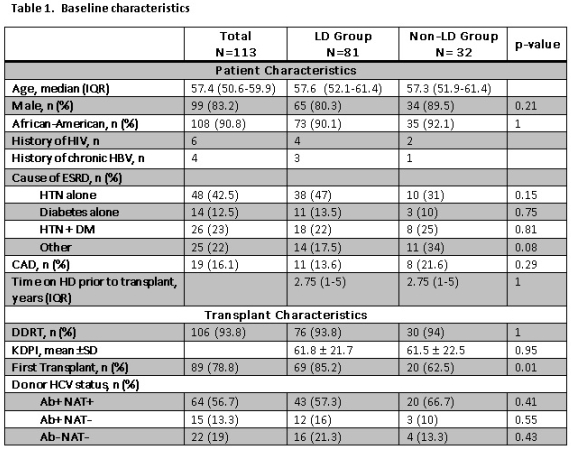Clinical and Pathological Findings in Hepatitis C Positive Renal Transplant Recipients Following Alemtuzumab Induction
University of Maryland Medical Center, Baltimore.
Meeting: 2018 American Transplant Congress
Abstract number: 216
Keywords: Hepatitis C, Induction therapy, Kidney transplantation
Session Information
Session Name: Concurrent Session: Kidney Immunosuppression: Induction Therapy
Session Type: Concurrent Session
Date: Monday, June 4, 2018
Session Time: 2:30pm-4:00pm
 Presentation Time: 3:30pm-3:42pm
Presentation Time: 3:30pm-3:42pm
Location: Room 6C
Background
Historically, renal transplant recipients (RTRs) with chronic hepatitis C (HCV) have worse long-term outcomes. Induction with alemtuzumab (ALM) in HCV positive RTRs has been postulated to contribute to HCV disease progression but the impact on histopathological findings has yet to be explored. We assessed the effect of ALM on graft outcomes using biopsy data from the first year post transplant in patients with HCV.
Methods
A retrospective cohort study of HCV positive RTRs from 1/2000 to 3/2017 was conducted. Maintenance immunosuppression included tacrolimus, MMF, and steroid taper per center protocol. The primary outcome was acute cellular rejection (AR); secondary outcome was graft survival.
Results
A total of 113 RTRs with HCV were identified, 91 patients received 179 biopsies within 1 year post transplant. Lymphocyte-depleting induction, with ALM or antithymocyte globulin (LD group) was used in 72% of RTRs while 28% received non-lymphocyte-depleting induction, including basiliximab or steroids alone (non-LD group). Baseline characteristics are summarized in Table 1. There was no difference in 1-year AR-free survival or graft survival between the LD and non-LD group (p=0.56, p=0.6). AR-free survival was similar in patients receiving HCV NAT positive versus HCV NAT negative donor organs (p=0.42). Graft survival was worse in the viremic donor group (p=0.045). In patients who received NAT positive donor organs, 19 grafts failed, of which 3 had been successfully treated for HCV.
Conclusion
ALM induction and donor HCV NAT status do not negatively impact one-year AR risk; however, HCV NAT positive donor status does portend worse long term graft survival. As the KDPI is equally impacted by HCV Ab and HCV NAT positivity, a modification of this algorithm may better predict graft survival. Larger studies are needed to confirm this finding.
CITATION INFORMATION: Jonchhe S., Husson J., Haririan A., Ravichandran B. Clinical and Pathological Findings in Hepatitis C Positive Renal Transplant Recipients Following Alemtuzumab Induction Am J Transplant. 2017;17 (suppl 3).
To cite this abstract in AMA style:
Jonchhe S, Husson J, Haririan A, Ravichandran B. Clinical and Pathological Findings in Hepatitis C Positive Renal Transplant Recipients Following Alemtuzumab Induction [abstract]. https://atcmeetingabstracts.com/abstract/clinical-and-pathological-findings-in-hepatitis-c-positive-renal-transplant-recipients-following-alemtuzumab-induction/. Accessed January 2, 2026.« Back to 2018 American Transplant Congress


